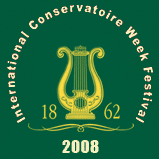
|
|||
 |
|||
 |
| CONCERT HALLS OF THE FESTIVAL |
THE ST. PETERSBURG
CONSERVATOIRE
GLAZUNOV HALL 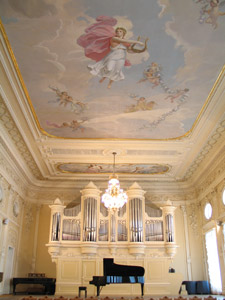 In 1887 to mark the 25th
anniversary of the St. Petersburg Conservatoire — Russia’s first higher music school —
emperor Alexander III issued
an order to rebuild Bolshoi
Theatre located in the Theatre square to house the Conservatoire. The contest was
arranged for the best project.
Vladimir Nikolas (1852-1902)
with his project became the
winner getting his big time as
engineer and architect. Nikolas
designed a concert hall for 600 seats on the second floor of the Conservatoire and named it “The Hall of Quartets’ meetings”. The Hall’s
decor combined early classicism with the elements of rococo. The
ceiling was adorned with a painting representing Apollo-Mussaget,
his wife Calliope and his son Orpheus, as well as muses: Polyhymnia
and Euterpe.
In 1887 to mark the 25th
anniversary of the St. Petersburg Conservatoire — Russia’s first higher music school —
emperor Alexander III issued
an order to rebuild Bolshoi
Theatre located in the Theatre square to house the Conservatoire. The contest was
arranged for the best project.
Vladimir Nikolas (1852-1902)
with his project became the
winner getting his big time as
engineer and architect. Nikolas
designed a concert hall for 600 seats on the second floor of the Conservatoire and named it “The Hall of Quartets’ meetings”. The Hall’s
decor combined early classicism with the elements of rococo. The
ceiling was adorned with a painting representing Apollo-Mussaget,
his wife Calliope and his son Orpheus, as well as muses: Polyhymnia
and Euterpe.
The plafond decorated by the artist Adrey Ryabushkin in 1894, was nearly destroyed during WWII. In 1970 a group of artists managed to recreate the painting. The artist-restorer A. Treskin followed Ryabushkin sketches when creating this plafond. Originally the hall housed the organ of the Dresden “Walker” company which has been replaced in 1961 by a “Riger-Kloss” organ made in Czechoslovakia. In 1980s this organ also broke down and remained silent for over two decades. In 2009 during the IX Conservatoire Week a special ceremony will be held to unveil a new “Eule” organ from Germany. Since the first concert, January 12, 1896 the Glazunov Concert Hall has always been a center of academic and artistic life in the Conserva- toire. It provides training stage and at the same time functions as an open concert hall. The Glazunov Hall preserves spiritual atmosphere of the Conservatoire, upholds its traditions and accumulates artistic energy provided by generations of musicians, who had performed there. Anna Esipova, Leopold Auer, Alexander Verzhbilovich, Vladimir Sophronitsky, Maria Yudina, Sergei Prokofiev, Dmitry Shostakovich, Artur Rubinstein, Glenn Guld, Mstislav Rostropovich and many other outstanding composers from Russia and abroad have performed in the Hall. In 1920 Maly Hall was named after Alexander Glazunov (1865-1936), former director of the Conservatoire who spent almost 25 years working in the music school. Since 2001 Glazunov Hall has become the main venue for the “International Conservatoire Week” Festival meant to integrate Russia’s oldest musical school into international musical environment and to hold up the status of the Hall as an international stage of the musical high school community.
GRAND HALL
OF ST. PETERSBURG
PHILHARMONICS
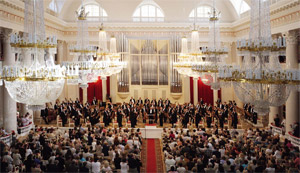 Òhe building housing the Philharmonia was constructed
in 1839 by the architect P. Jacot
(Carlo Rossi’s pupil) for the St. Petersburg Assembly of the Noble.
The hall with wonderful acoustics
and a seating capacity of over 1500
has been the center of the city’s
musical life since the end of 1840s.
Numerous renowned musicians of
the XIX century performed here. F. Lizst, H. Berlioz, R. Wagner, G. Mahler, A. Rubinstein, K. Schumann, P. Viardo, P. Sarasate and others were
among them. Many works of such exponents of Russian classical tradition
as Borodin, Mussorgsky, Tchaikovsky, Rimsky-Korsakov, Glazunov were
premiered here.
Òhe building housing the Philharmonia was constructed
in 1839 by the architect P. Jacot
(Carlo Rossi’s pupil) for the St. Petersburg Assembly of the Noble.
The hall with wonderful acoustics
and a seating capacity of over 1500
has been the center of the city’s
musical life since the end of 1840s.
Numerous renowned musicians of
the XIX century performed here. F. Lizst, H. Berlioz, R. Wagner, G. Mahler, A. Rubinstein, K. Schumann, P. Viardo, P. Sarasate and others were
among them. Many works of such exponents of Russian classical tradition
as Borodin, Mussorgsky, Tchaikovsky, Rimsky-Korsakov, Glazunov were
premiered here.June 12, 1921 the Hall featured opening ceremony of the Petrograd Philharmonia. Within a short period of time the Philharmonia developed diverse concert, educational and publishing activities; the unique Philharmonic Library was also of great help. The Philharmonic Orchestra (at present the St. Petersburg Philharmonic) became its leading orchestra. In the course of 50 years (1938– 1988) it was headed by the outstanding Russian conductor Evgeny Mravinsky. Since 1988 Yuri Temirkanov, one of the world’s leading conductors, has been Artistic Director and Chief Conductor of the Orchestra. The second orchestra of the Philharmonics — Academic Symphony Orchestra — is headed by Alexander Dmitriev. 20th century saw the best contemporary musicians: O. Klemperer, B. Walter, E .Ansermet, E. Kleiber, L. Stokowski, A. Cortot, A. Schna- bel, A. Rubinstein, B. Britten, F. Fischer-Diskau, S. Richter, E. Gilels, A. B. Michelangeli, G. Gould, Y. Menuchin, M. Rostropovich performing in the Hall. Among the orchestras that gave concerts here were the Philadelphia, Cleveland, Chicago Orchestras, the Berlin, Vienna and New-York Phil- harmonic Orchestras, the Konzertgebau of Amsterdam. Some great careers started here: Shostakovich’s First Symphony was premiered here on May 12, 1926. The Philharmonia now bears the name of the great composer. The Grand Hall of the St. Petersburg Philharmonia is one of the best concert halls in Europe. It is considered to be prestigious and honorable to perform here.
GRAND HALL OF EKATERINA’S PALACE
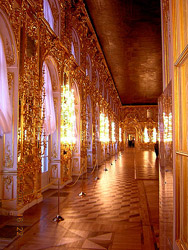 Tsarskoe Selo was created in the 18th
Century as a gala residence. The design
for Catherine’s Palace was begun by M. Zemtsov
and A. Kvasov. Begin ning in 1748, the project was
headed by architect V. Rastrelli who developed
the general construction plan for the palace
and park. The golden suite of gala halls with the
radiantly mirrored Grand Hall and newly restored
Amber Room amaze and delight all those fortunate
enough to visit them.
Tsarskoe Selo was created in the 18th
Century as a gala residence. The design
for Catherine’s Palace was begun by M. Zemtsov
and A. Kvasov. Begin ning in 1748, the project was
headed by architect V. Rastrelli who developed
the general construction plan for the palace
and park. The golden suite of gala halls with the
radiantly mirrored Grand Hall and newly restored
Amber Room amaze and delight all those fortunate
enough to visit them.
SHEREMETEV PALACE 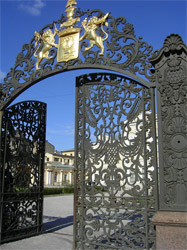 In 1712 a plot on the Fontanka River was
given by Peter I to Field-Marshal, Count
B. P. Sheremetev, praised for his victories in the
Northern War. The construction of the two-story
stone palace was completed in 1750 (architect
C. I. Tchevakinsky). There is a reason to believe that
F.-B. Rastrelli’s plans were used in the design. After
the revolution (from 1918–1929) the Fountain House
received status as a museum of court life. The principle holdings for this museum were the collections of
the Sheremetev Counts, including a painting gallery,
sculptures, weaponry, numismatics, decorative art
furnishings, library houses (music and literary col-
lections, and manuscripts), icons and church utensils, and the She remetev family archive. The Saint
Petersburg Sheremetev Palace Musical Instruments Collection of more than
3000 items started by Baron K. K. Shtakel berg, Court Orchestra Supervisor.
In 1712 a plot on the Fontanka River was
given by Peter I to Field-Marshal, Count
B. P. Sheremetev, praised for his victories in the
Northern War. The construction of the two-story
stone palace was completed in 1750 (architect
C. I. Tchevakinsky). There is a reason to believe that
F.-B. Rastrelli’s plans were used in the design. After
the revolution (from 1918–1929) the Fountain House
received status as a museum of court life. The principle holdings for this museum were the collections of
the Sheremetev Counts, including a painting gallery,
sculptures, weaponry, numismatics, decorative art
furnishings, library houses (music and literary col-
lections, and manuscripts), icons and church utensils, and the She remetev family archive. The Saint
Petersburg Sheremetev Palace Musical Instruments Collection of more than
3000 items started by Baron K. K. Shtakel berg, Court Orchestra Supervisor. |

